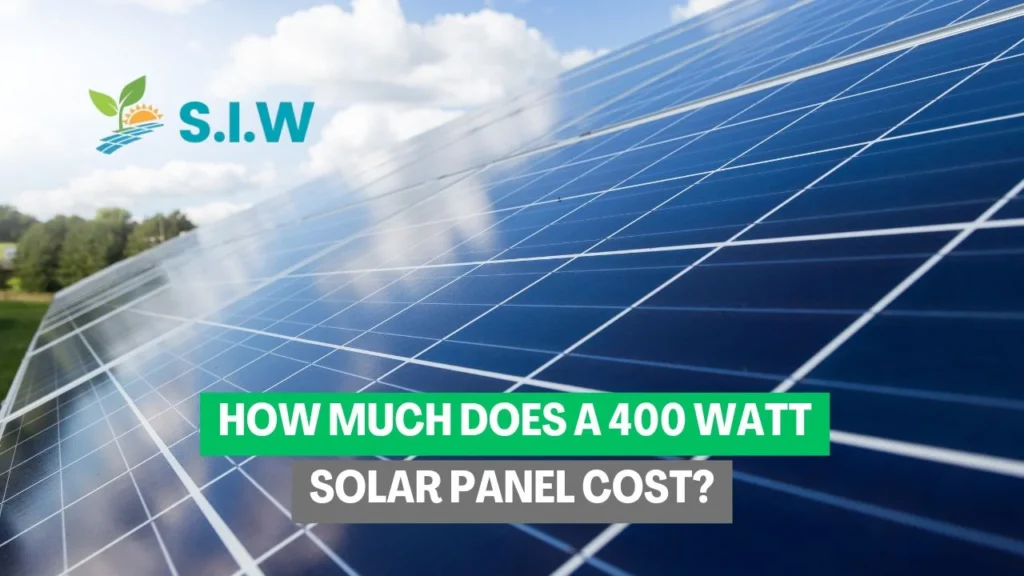1. Overview
Solar energy has grown into one of the most efficient and eco-friendly ways to power homes and businesses. In particular, 400-watt solar panels are gaining popularity due to their balance of size, output, and affordability. This article will explore the costs associated with 400W solar panels, including factors like brand, installation, and potential savings.
2. Understanding Solar Panel Pricing
Factors Affecting Solar Panel Costs
Several factors influence the price of a solar panel. These include panel type (monocrystalline, polycrystalline, or thin-film), efficiency, and the manufacturer’s reputation.
Solar Panel Types and Efficiency
Monocrystalline Solar Panels, known for their higher efficiency, often come at a premium, while polycrystalline panels are more affordable but less efficient.
3. Price of a 400 Watt Solar Panel
Average Cost
The cost of a 400W solar panel typically ranges from $200 to $450, depending on brand and quality.
Cost Comparison by Brand
Higher-end brands, such as LG or SunPower, may charge more, while more affordable options include brands like Canadian Solar or JinkoSolar.
Bulk Pricing
Purchasing panels in bulk often results in discounted rates, which is ideal for large installations.
4. Installation Costs
Professional vs. DIY Installation
Hiring a professional installer typically adds $500 to $1,000 to the total cost, depending on the complexity of the installation. A DIY solar installation can save money but requires expertise.
Additional Costs (Permits, Labor)
Installation permits, labor, and electrical work can add anywhere from $500 to $2,000 to the overall price.
5. Cost Savings and Financial Benefits
Energy Savings
A 400W panel can produce around 1.2 to 1.5 kWh of energy per day, potentially saving hundreds of dollars annually on electricity bills.
Tax Incentives and Rebates
Government incentives, like the federal tax credit, can offset up to 26% of installation costs. Additionally, many states offer rebates and tax incentives.
Return on Investment (ROI)
With potential energy savings and tax benefits, many homeowners see a full return on investment within 5 to 8 years.
6. Geographical Factors
Impact of Location on Costs
Solar panel pricing and installation costs can vary depending on your location. Areas with more sunshine often see higher returns on solar investments.
Solar Incentive Programs in Different Regions
States like California and New York offer more generous incentives, reducing the overall cost of going solar.
7. Quality and Warranty Considerations
Importance of Quality
Higher-quality panels generally come with a premium but offer better long-term performance and durability.
Warranty Coverage and What It Includes
Many solar panels come with a 25-year warranty, covering both performance and manufacturing defects, offering peace of mind for buyers.
8. Comparison of 400 Watt Panels with Other Wattages
400W vs. 300W
A 400W panel offers about 33% more power than a 300W panel, which could mean fewer panels are required for the same energy output.
400W vs. 500W Panels
While 500W panels provide more energy, they are also larger and more expensive, making 400W panels a better fit for most residential systems.
Efficiency and Space Considerations
400W panels strike a balance between space and efficiency, making them ideal for homeowners with limited roof space.
9. Case Study: Cost of Installing a 400W Solar System
Real-World Example
A typical residential setup with 10 panels (4000 watts) costs around $6,000 to $10,000, including installation.
Total Cost Breakdown
The total cost includes the price of panels, installation labor, permits, and additional equipment like inverters and mounting hardware.
10. Financing Options for Solar Panels
Loans
Homeowners can finance solar panel purchases through personal loans, which allow for upfront costs to be spread over time.
Leases
Solar leasing allows homeowners to rent solar panels and pay for the energy they generate.
Power Purchase Agreements (PPA)
With a PPA, you can purchase solar power at a fixed rate without the upfront cost of installation.
11. Future Trends in Solar Panel Costs
Expected Cost Reductions
As solar technology continues to evolve, the cost of solar panels is expected to decrease, making solar power even more accessible.
New Technologies Impacting Pricing
Innovations like bifacial panels and improved battery storage may further reduce costs and increase efficiency.
12. Practical Applications of 400W Solar Panels
Residential Uses
400W panels are a great fit for residential rooftops, providing enough power for homes while saving space.
Commercial Uses
Businesses can use 400W panels to reduce electricity costs and improve sustainability.
Off-Grid Applications
For those living in remote areas, 400W panels can power off-grid systems efficiently.
13. FAQs
- How much do 400W solar panels cost on average?
The average cost is between $200 and $450, depending on the brand and quality. - What’s the difference between monocrystalline and polycrystalline panels?
Monocrystalline panels are more efficient but costlier than polycrystalline panels. - How long does it take to break even on solar panels?
Most homeowners see a return on investment within 5-8 years.
14. Expert Insights on Solar Panels
Experts in the field predict that the cost of solar panels will continue to drop as new technologies emerge. Many recommend investing now to take advantage of current tax incentives.
15. Conclusion
Investing in 400-watt solar panels offers a balanced solution for energy savings, sustainability, and long-term benefits. With current tax incentives and the potential for reduced energy bills, now is the perfect time to consider going solar.








